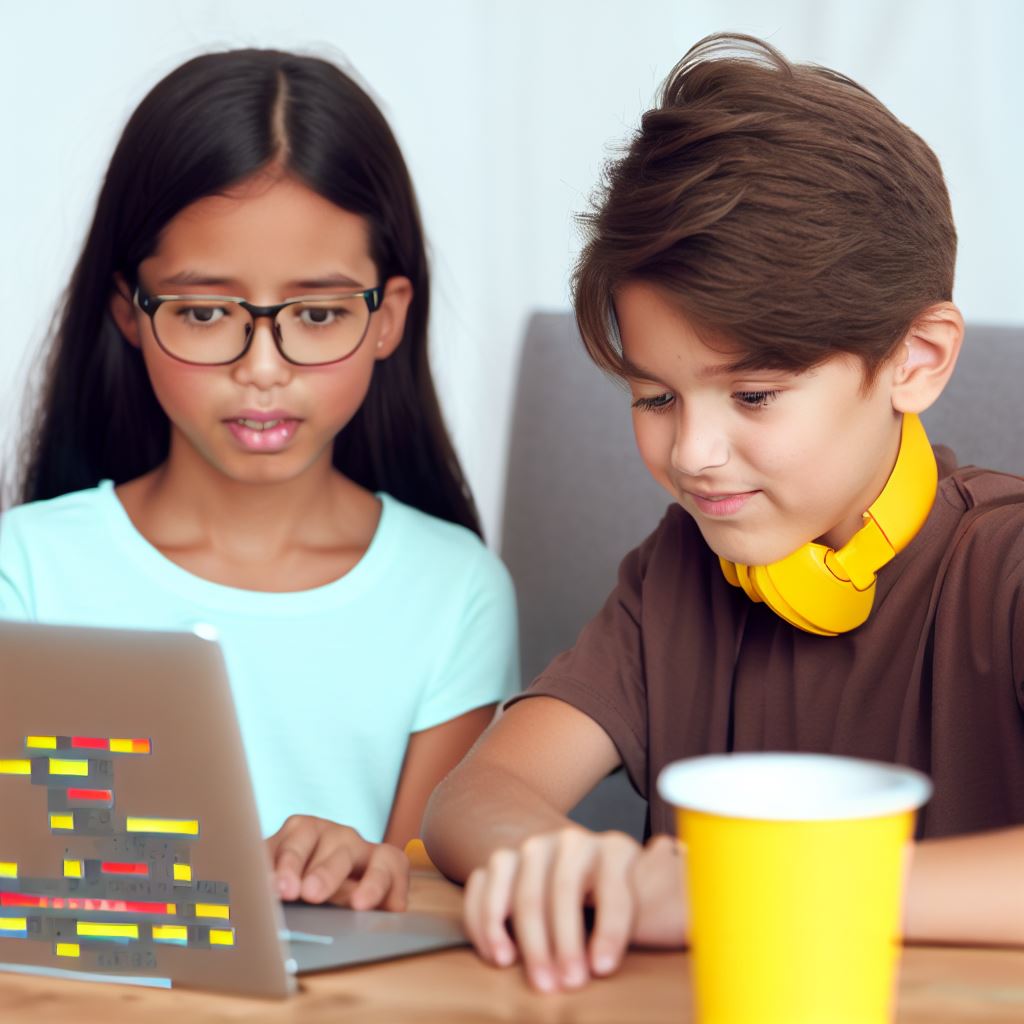Introduction
When it comes to introducing kids to coding, many parents may assume that a computer is necessary. However, this is a misconception that can limit their understanding and potential in coding.
Coding skills are becoming increasingly important in today’s digital world. Not only does coding enhance problem-solving and logic skills, but it also fosters creativity and critical thinking.
Introducing kids to coding at an early age helps them develop these skills, preparing them for the future.
Contrary to popular belief, coding does not always require a computer. It can be introduced through unplugged activities that engage kids in learning the fundamentals of coding principles and logic.
By removing the computer from the equation, children can grasp the core concepts without feeling overwhelmed by technology.
By using various offline coding activities, such as board games, puzzles, and hands-on experiments, kids can explore and practice coding concepts and algorithms.
These activities allow them to understand the logic and sequencing involved in coding, even without direct computer interaction.
Another effective way to introduce coding without a computer is through storytelling or role-playing. Kids can imagine themselves as characters in a story and make decisions using coding concepts.
This interactive and imaginative approach makes coding more accessible and enjoyable for young learners.
In essence, it is vital to understand that coding skills can be introduced to kids without the need for a computer.
By utilizing unplugged activities and creative methods, parents can foster their children’s coding abilities, helping them develop critical skills for the future.
Understanding the Basics of Coding
Coding is the process of creating instructions for a computer to follow in order to perform specific tasks. Its purpose is to solve problems and automate tasks.
By teaching your kids coding, you are helping them develop problem-solving skills and logical thinking.
Definition of Coding and Its Purpose
Coding involves writing instructions using a programming language to tell a computer what to do.
It is the language of computers and is used for various purposes, such as software development, web development, and data analysis.
Tech Consulting Tailored to Your Coding Journey
Get expert guidance in coding with a personalized consultation. Receive unique, actionable insights delivered in 1-3 business days.
Get StartedExplanation of Simple Coding Concepts
To introduce your kids to coding without a computer, you can start by explaining some basic coding concepts. Here are a few essential concepts you can teach them:
- Algorithms: An algorithm is a step-by-step procedure or set of rules used to solve a problem or perform a particular task. It is like a recipe that guides the computer on what actions to take.
- Sequences: Sequences represent the exact order of steps that need to be followed. It involves breaking down a task into smaller steps and executing them in a specific order.
- Conditions: Conditions are used to make decisions based on specific criteria. They allow the computer to choose between different paths or actions based on certain conditions being met or not.
- Loops: Loops are used to repeat a set of instructions multiple times. They allow for efficient and repetitive tasks, such as printing numbers from 1 to 10 or performing calculations on a set of data.
By teaching your kids these coding concepts, you are introducing them to the building blocks of programming and helping them understand how computers work.
Read: The Rise of Coding Bootcamps: Coding Dojo’s Journey
Activities to Teach Coding without a Computer
Now that you have a basic understanding of coding concepts, here are some activities you can do with your kids to teach them coding without a computer:
- Create an Algorithm Dance: Ask your kids to create a sequence of dance moves using simple instructions like “take one step forward” or “turn to the right.”
- Build a LEGO Maze: Using LEGO bricks, have your kids build a maze and create an algorithm to navigate through it.
They can use directional instructions like “move forward,” “turn left,” or “turn right” to guide a small toy car through the maze. - Design a Treasure Hunt: Create a treasure hunt by hiding objects around the house. Provide your kids with a series of clues that involve sequences, conditions, and loops to solve the hunt.
- Play Simon Says: Have a game of Simon Says where you give instructions that involve conditions like “Simon says touch your nose if you’re wearing blue” or “Simon says clap three times.”
These activities will not only engage your kids in a fun and interactive way but also provide them with a solid foundation in coding principles.
Introducing coding to kids without a computer can be a fun and engaging way to develop their problem-solving and logical thinking skills.
There are several activities and games that can help children understand the basic concepts of coding.
These activities, known as unplugged coding games, require no screens or devices and can be easily implemented at home or in the classroom.
Unplugged Coding Games
Unplugged coding refers to activities that teach computational thinking and coding principles without the use of a computer.
These games not only introduce children to the fundamentals of coding but also encourage collaboration, creativity, and critical thinking.
Simon Says Coding Game
In this game, one child acts as the “coder” while the other children play the role of “computers.”
The coder gives instructions using coding concepts, such as forward, backward, turn left, or turn right, and the “computers” follow these commands to reach a specific destination or complete a task.
For example, the coder may say, “Simon says move forward three steps,” and the “computers” have to follow the instruction. This game teaches children the importance of precise instructions and logical sequencing.
Human Robot Coding
This game involves one child acting as a “robot” while the others give instructions to navigate the “robot” to a specific location.
Build Your Vision, Perfectly Tailored
Get a custom-built website or application that matches your vision and needs. Stand out from the crowd with a solution designed just for you—professional, scalable, and seamless.
Get StartedThe instructions can include simple commands like walk forward, turn right, or turn left.
The children take turns being the “robot” and the “programmer,” allowing everyone to experience both roles.
This activity helps children understand how programs provide step-by-step instructions to guide a computer or robot’s actions.
The Cup Stacks Coding Challenge
The Cup Stacks Coding Challenge is a game that introduces the concept of conditionals and loops. Children arrange plastic cups in different patterns, and each pattern represents a specific code.
They then need to write a set of instructions using coding logic to guide their partner in recreating the pattern using the cups.
For example, if a cup is represented by the number 1 and the stacking pattern is 1-2-3-2, the coder must explain how to stack the cups to their partner without showing them the actual pattern.
This encourages children to think algorithmically and develop logical thinking skills.
By introducing coding through offline methods, children can develop a strong foundation in computational thinking, which can ultimately prepare them for learning coding languages and programming in the future.
So, why wait? Start introducing your kids to coding without a computer today with these exciting unplugged coding games!
Coding is a valuable skill that has become increasingly important in today’s digital age.
Introducing your kids to coding at an early age can equip them with problem-solving, critical thinking, and creativity skills that will benefit them in the future.
While it may seem like coding requires a computer, there are actually many ways to teach coding offline.
Read: Mentorship at Coding Dojo: How Instructors Make a Difference

Offline Coding Projects
Offline coding projects allow kids to learn the basics of coding without the need for a computer. These activities are not only fun but also help to develop logical thinking and sequencing skills.
Optimize Your Profile, Get Noticed
Make your resume and LinkedIn stand out to employers with a profile that highlights your technical skills and project experience. Elevate your career with a polished and professional presence.
Get NoticedOne great offline coding project is creating a cardboard maze and coding a toy to navigate through it. Kids can design and build their own mazes using cardboard boxes and craft materials.
They can then use coding concepts to program a toy, such as a robot or remote-controlled car, to find its way through the maze. This project introduces kids to the idea of giving instructions and following a sequence of steps.
Another engaging activity is building a binary code bracelet using beads and string. Binary code is the fundamental language of computers, and this project teaches kids the binary number system.
They can assign different colors to represent 0s and 1s, and then string the beads in a pattern that spells out their name or a message. This activity helps kids understand how computers store and process information.
Introduction to Tangible Coding
Tangible coding is another way to introduce kids to coding without a computer. It involves using physical objects, such as coding blocks or cards, to create sequences of instructions.
Coding blocks are physical blocks with different commands or actions written on them. Kids can stack these blocks in a particular order to create a sequence of instructions.
For example, they can connect a block that says “move forward” with a block that says “turn right” to make a robot move in a certain direction.
This hands-on approach allows kids to understand the concept of sequencing and develop their problem-solving skills.
Coding cards are another tangible coding tool that can be used offline. These cards have different commands or actions printed on them, and kids can arrange them in a specific order to create a program.
They can then act out the program step by step to see the results. This activity encourages creativity and helps kids understand the cause-and-effect relationship between their instructions and the outcome.
Suggest Activities
Here are some more activities you can suggest to introduce your kids to coding offline:
- Create a treasure hunt where kids need to follow a series of clues, using coding concepts like conditionals and loops.
- Design and build a simple circuit using electronic components like LEDs and resistors. This activity teaches kids about basic electrical circuits and how they can be controlled.
- Encourage your kids to write a story or create a comic strip featuring a character who encounters coding challenges. This activity combines coding concepts with storytelling and artistic expression.
By engaging your kids in these offline coding projects and activities, you can ignite their interest in coding and provide them with a solid foundation for future learning.
Remember, coding is not just about computers – it’s a skill that can be developed through hands-on and creative experiences.
So, don’t wait! Start exploring the world of offline coding with your kids today!
Read: The Link Between Math and Coding: What You Need to Know
Books and Resources for Introducing Kids to Coding
Recommendations for Books on Coding for Kids
- “Hello Ruby: Adventures in Coding” by Linda Liukas – A fun storybook that introduces programming concepts.
- “Coding for Beginners Using Scratch” by Jon Woodcock – Teaches kids to code through interactive projects.
- “Coding Games in Python” by Christian Thompson – Engaging guide that teaches coding using the Python language.
- “How to Code: A Step-by-Step Guide to Computer Coding” by Max Wainewright – Beginner-friendly book with visual explanations.
Coding Board Games and Puzzles
- Robot Turtles – A board game that teaches the fundamentals of programming to young children.
- Code Monkey Island – A strategic game that encourages problem-solving and logical thinking.
- Bits and Bytes – A puzzle game where kids arrange and connect coding tiles to solve challenges.
Coding Apps and Software for Offline Use
Introducing your kids to coding doesn’t always require a computer.
With the abundance of books, coding board games, and offline coding apps available, children can develop their coding skills without a screen.
These resources not only make learning enjoyable but also boost critical thinking, problem-solving, and creativity.
Books play a crucial role in engaging young minds in coding. “Hello Ruby: Adventures in Coding” is a highly recommended storybook that sparks curiosity and introduces basic coding concepts.
Coding board games and puzzles provide a fun and interactive way to introduce coding concepts.
Robot Turtles, for example, turns coding into a game where kids maneuver a robot through a maze using basic programming commands.
Code Monkey Island challenges players to solve puzzles by programming monkeys to navigate obstacles, teaching logic and strategy.
Offline coding apps and software are great alternatives when a computer is not available. The Scratch Offline Editor, a standalone program, enables kids to express their creativity through coding, creating stories, games, and animations.
Code.org’s Unplugged Activities offer printable exercises that introduce real coding concepts without the need for a screen.
Ozobot Offline Play allows kids to program a physical robot using markers and paper, enhancing their coding skills through hands-on experience.
In general, there are numerous books, coding board games, and offline coding apps that parents can utilize to introduce their kids to coding without a computer.
Read: Behind the Scenes: The Evolution of Top Coding Organizations
Uncover the Details: A Beginner’s Guide to Understanding DNA Strands
Benefits of Introducing Coding Without a Computer
When it comes to teaching kids coding, many parents and educators assume that a computer is a must-have tool. However, coding can be introduced without a computer, and this alternative approach offers several benefits:
Development of Problem-Solving Skills
- By introducing coding activities that don’t involve a computer, children are encouraged to think critically and solve problems in a creative manner.
- Offline coding exercises, such as board games or interactive puzzles, allow kids to break down complex problems into smaller, manageable tasks.
- These activities promote logical thinking and improve problem-solving skills, which are valuable in various aspects of life.
Encouragement of Creativity and Logical Thinking
- Coding without a computer encourages children to use their imagination and think outside the box.
- Offline coding activities often involve designing and creating physical objects or structures, fostering creativity.
- Children can experiment with different solutions and learn to anticipate potential challenges.
- Through logical thinking, they develop the ability to find efficient and innovative approaches to problems.
Preparation for Future Technology-Driven Careers
- Introducing coding without a computer prepares children for technology-driven careers in a comprehensive way.
- While computer programming is crucial, it is equally important for kids to understand the fundamental principles of coding.
- By starting with physical coding exercises, children gain a solid foundation in computational thinking and problem-solving.
- These skills can then be transferred to computer programming when they are ready to explore coding on a digital platform.
- Early exposure to coding concepts boosts their confidence and sets them up for success in the future.
So, how can you introduce your kids to coding without a computer? Here are some ideas:
Coding Board Games
Engage your kids with board games that incorporate coding concepts. Games like Robot Turtles, Code Master, or Hacker help them learn coding principles while having fun.
Unplugged Coding Activities
Unplugged coding activities offer hands-on experiences without the need for a computer. Activities like creating algorithms with physical objects or simulating coding sequences develop critical thinking skills.
Coding with Crafts
Combine coding with craft projects by having your kids create their own binary bracelets, where they translate their names into binary code using beads or color patterns.
Make It Physical
Build a coding-inspired obstacle course where kids navigate through a series of physical challenges representing coding concepts like loops, conditionals, and sequences.
Coding Through Storytelling
Create storytelling activities that involve coding. Let kids imagine and draw their own stories, incorporating elements like algorithms, loops, and decisions.
Introducing coding without a computer provides numerous benefits, from enhancing problem-solving skills and nurturing creativity to preparing kids for future careers.
So, don’t hesitate to explore these alternative methods and make coding a fun and engaging activity for your children.
Conclusion
Introducing coding to kids is highly beneficial for their future success. It fosters problem-solving skills, logical thinking, and creativity.
Moreover, coding can be learned without a computer, making it accessible to all children.
By engaging in activities such as coding games, unplugged coding, and using coding toys, parents can provide a stimulating learning environment for their kids.
It is important for parents to start introducing coding to their kids at an early age. This will give them a head start in a world that increasingly relies on technology.
By introducing coding without a computer, children can develop an understanding of the fundamental concepts that will be useful when they eventually start coding on a digital platform.
So, don’t wait any longer! Start exploring the world of coding with your kids today, and watch them develop valuable skills that will benefit them throughout their lives.




